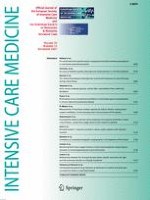01-12-2007 | Original
Strict versus moderate glucose control after resuscitation from ventricular fibrillation
Published in: Intensive Care Medicine | Issue 12/2007
Login to get accessAbstract
Objective
Elevated blood glucose is associated with poor outcome in patients resuscitated from out-of-hospital cardiac arrest (OHCA). Our aim was to determine whether strict glucose control with intensive insulin treatment improves outcome of OHCA patients.
Design
A randomized, controlled trial.
Setting
Two university hospital intensive care units.
Patients
Ninety patients resuscitated from OHCA with ventricular fibrillation detected as the initial rhythm were treated with therapeutic hypothermia.
Interventions
Patients were randomized into two treatment groups: a strict glucose control group (SGC group), with a blood glucose target of 4–6 mmol/l, or a moderate glucose control group (MGC group), with a blood glucose target of 6–8 mmol/l. Both groups were treated with insulin infusion for 48 h, because a control group with no treatment was considered unethical.
Measurements and results
Baseline data were similar in both groups. In the SGC group 71% of the glucose measurements were within the target range compared with 41% in the MGC group. Median glucose was 5.0 mmol/l in the SGC group and 6.4 mmol/l in the MGC group. The occurrence of moderate hypoglycemic episodes was 18% in the SGC group and 2% in the MGC group (p = 0.008). No episodes of severe hypoglycemia occurred. Mortality by day 30 was 33% in the SGC group and 35% in the MGC group (p = 0.846); the difference was 2% (95% CI –18% to +22%).
Conclusions
We found no additional survival benefit from strict glucose control compared with moderate glucose control with a target between 6 and 8 mmol/l in OHCA patients.





